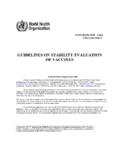Transcription of IMPACT OF HIGH FOOD PRICES ON NUTRITION
1 IMPACT OF high food PRICES ON. NUTRITION . Janice Meerman 1, Juliet Aphane 2. FAO NUTRITION Division (ESN). This paper was originally written as a chapter for the Proceedings for FAO's Expert Consultation on Policy Responses to high and Volatile food PRICES , held in November 2012. 1. Consultant, FAO NUTRITION Division 2. NUTRITION Officer, FAO NUTRITION Division CONTENTS. 1. Abstract .. 3. 2. Introduction .. 3. 3. IMPACT of high food PRICES on 4. 4. IMPACT of high food PRICES on NUTRITION : vulnerable populations .. 6. 5. Mitigating the IMPACT of high food PRICES on NUTRITION .. 9. 6. Lessons learned .. 13. 7. Policy proposals .. 14. 8. Conclusion .. 16. References .. 18. 2. 1. ABSTRACT. While decreased dietary quality and quantity are the most immediate effect of high food PRICES on NUTRITION , IMPACT extends far further. At household level, child growth and cognitive development may be compromised, macro and micronutrient deficiencies for all family members are likely to occur, and the risk of infant and maternal mortality goes up.
2 Second-order impacts at household level include decreased utilization of health services, decreased school attendance, and increased workload for women. At national level, prevalence of stunting, underweight and other forms of malnutrition may increase, slowing human development and economic growth. At global level, these outcomes threaten achievement of multiple MDGs. In addition to more detail on each of these outcomes, this paper provides information on how the NUTRITION statuses of specific demographics are affected by food price spikes. Three of the most frequently cited ways to reduce vulnerability in these populations social safety nets, community based NUTRITION programmes, and NUTRITION -enhancing agriculture - are discussed. The paper also includes lessons learned regarding the imperative of maintaining public services during a food price spike and the political economy of NUTRITION policy reform.
3 The paper concludes with three policy proposals for increasing NUTRITION resilience against food price and other shocks: using existing survey tools to capture new information on food and NUTRITION security; using government strengths in decentralization, social mobilization and other areas to build operational capacity; and promoting the concept of win-wins to advocate for increased NUTRITION sensitivity in agriculture. 2. INTRODUCTION. Large, sudden and unexpected increases in food PRICES force people to adjust quickly. Consumer purchasing power goes down and households are pushed closer to or below poverty lines. This is especially true for urban families, rural households that are net consumers, and for households headed by women. What does this mean for NUTRITION ? At household and individual level, it means that both dietary quality and total energy intake may be reduced, compromising child growth and cognitive development, increasing risk of micronutrient deficiencies for all family members, and increasing risk of infant and maternal mortality.
4 It means that at national level, prevalence of stunting, underweight and other forms of malnutrition may increase, slowing human development and economic growth. At global level, these outcomes threaten achievement of multiple MDGs. This paper takes a closer look at these issues. It begins with more information on how high food PRICES IMPACT NUTRITION at household, national and global levels and then describes how they are affecting NUTRITION outcomes in high -risk population groups. Three of the most frequently cited ways to reduce vulnerability in these populations are discussed. The last sections present lessons learned and policy proposals for getting and keeping effective NUTRITION policies on national development agendas, even in situations where food PRICES remain high and volatile. 3. 3. IMPACT OF high food PRICES ON NUTRITION .
5 Unless otherwise stated, the sections below assume households are net food buyers experiencing some price transmission from international or regional to domestic markets. The focus is primarily on sub-Saharan Africa and South Asia. Although the latter is self-sufficient in rice, some countries remain net food importers and regardless, the share of food in South Asian household expenditures is high at approximately 40 percent (World Bank, 2012). Prevalence estimates of undernourishment and chronic malnutrition are also highest in these two regions 3. (FAO 2012; UNICEF, WHO, World Bank, 2012). ) IMPACT on households and individuals Shifting from a varied diet rich in micronutrients to one that is derived predominantly from high - carbohydrate staples is a common response to declines in income. This is because most staple foods ( rice, maize, cassava) are much cheaper than fruits, vegetables and animal source foods.
6 However, when staples are eaten on their own or with very small amounts of other foods, the result is a poor quality, monotonous diet that is likely to be nutritionally inadequate in protein, fats and micronutrients (Thompson 2009). For example, cassava root, one of the cheapest and hence most popular staple foods in much of sub-Saharan Africa, is particularly low in protein ( g protein/100 raw edible grams as compared to g for rice) (Stadlmayr et al., 2012). Nevertheless demand for cassava increased among many cash-strapped households in sub- Saharan Africa in 2008 (FAO, 2009). When households replace meat, fruits, vegetables and other micronutrient-rich foods with high carbohydrate staples, their energy intake may remain above the minimum requirement, but both macro and micronutrient intake is compromised, thus increasing risk of stunting, micronutrient deficiencies and associated poor health outcomes.
7 For instance, Vitamin A deficiency (VAD). and iron deficiency anaemia (IDA) - two of the most common nutritional deficiencies in the world are caused by diets low in animal source foods, fat, and certain fruits and vegetables. VAD is associated with impaired immunological function, increased risk of maternal and infant death, and impaired eyesight. IDA affects physical productivity in adults and cognitive and physical development in children. It is particularly detrimental during pregnancy when women's iron requirements are high . Both deficiencies are associated with increased healthcare costs and compromised human capital (Horton and Ross, 2003; FAO, 2004; World Bank, 2006). If PRICES rise further and downgrading dietary quality is not enough, total caloric intake will be reduced. In addition to further increasing malnutrition, reducing total energy intake also increases risk of health shocks.
8 This is because inadequate dietary intake weakens the immune system and increases susceptibility to disease. Infectious disease, in turn, increases nutrient requirements and weakens the immune system. This vicious circle can begin when dietary intake is inadequate in terms of quality but still acceptable in regards to total caloric intake. The situation worsens once energy requirements are no longer met. Intrahousehold food reallocation may help reduce all these effects for some family members but at the expense of others. It occurs most commonly when women become shock absorbers of 3. Prevalence of undernourishment (2010-2012): percent in South Asia & percent in sub-Saharan Africa (FAO 2012). Prevalence of stunting (2011): 37 percent in South Asia & 40 percent in sub-Saharan Africa (UNICEF, WHO, World Bank, 2012). 4. household food insecurity (Quisumbing, Meinzen-Dick, and Bassett, 2008) by reducing their own intake in order to increase food availability for other household members.
9 This can have immediate and long-term repercussions in terms of maternal and (consequently). intergenerational malnutrition. In addition to compromising dietary quality and quantity, high food PRICES also have second- order impacts on households and individuals which can IMPACT NUTRITION indirectly (Thompson 2009). Two of the most detrimental are decreased school attendance and decreased spending on healthcare. As described above, infection increases malnutrition and vice-versa. As such, decreased spending on healthcare implies increased risk of poor NUTRITION outcomes. The relationship between education and NUTRITION is more distal but no less important, schools provide an important delivery platform for learning about good NUTRITION as well as for direct NUTRITION interventions. Both are especially crucial for girls, who, as described below, have an essential future role to play in assuring household NUTRITION security.
10 Another second-order IMPACT is increased workforce participation of women. In non-crisis settings, mothers have been shown to manage childcare efficiently, resulting in a net-positive effect (Levin et al. 1999, Ruel et al. 1999, Ruel et al. 2002). In contrast, when women seek work under distressed conditions such as those caused by a food price spike, child welfare . including NUTRITION - is more likely to suffer (World Bank, 2012). ) IMPACT at country level Economic analyses of the costs of malnutrition have examined specific micronutrient deficiencies as well as chronic undernutrition or stunting. For example, iron deficiency in adults has been estimated to decrease national labour productivity by 5 to 17 percent (Horton, 1999), and up to 10% in lost productivity and earnings has been attributed to stunting (FAO, 2004).

















